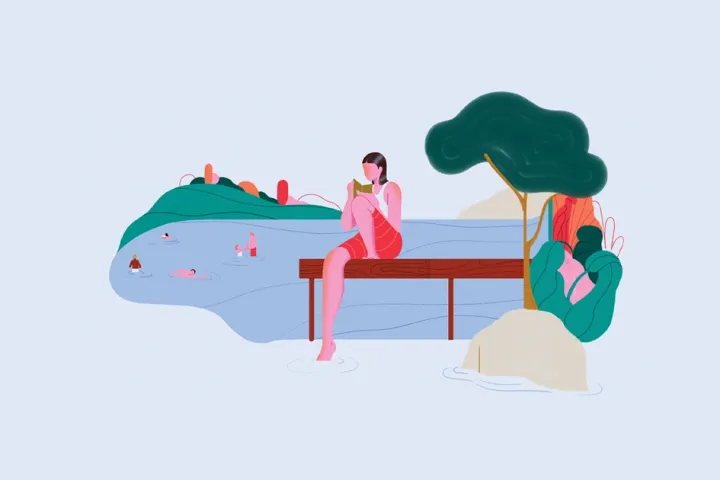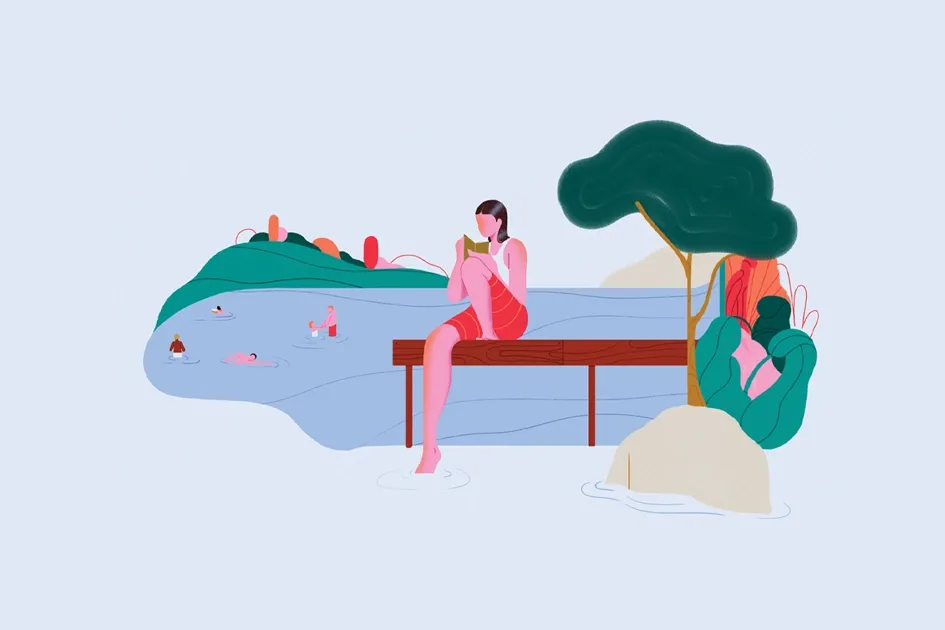I have a friend who visited a monastery in west central Kentucky not long ago, for a day retreat with a couple of companions. Retreat is an apt word: Situated in Trappist, where the nearest neighbors are in New Haven, Gethsemani is low on hustle and bustle but rich in silence, framed by woods. It was in the dead of a heat wave, and my friend, always up for an adventure, had rallied a small group to an afternoon swim in one of the pond-ish lakes that dotted the countryside. While hoisting himself onto a half-submerged log, a broken-off branch beneath the surface pierced my friend’s thigh. Blessedly, it missed his femoral artery. Still, the bleeding was profuse so he called out to the others for help. He needed a doctor, and quickly. After some quick triage with a white T-shirt for a tourniquet, they piled into the car and drove to the nearest hospital. Given that it was near the cloistered kind of middle-of-nowhere that appeals to Trappist monks, you could say this hospital was remote. There, after hours of waiting and some double and octuple checking that it wasn’t a gunshot wound after all, the staff stitched him up and sent him on his way. It looked as if things were OK. Except, all was well until it wasn’t. As it turns out, stitching a deep puncture wound recently baptized in pond water is exactly the wrong way to promote healing. Three days later, back at home in Louisville, he was admitted to the hospital with a wicked infection.
Our bodies are fragile and yet resilient. Left to themselves, our bodies may be able to piece themselves back together. But do our hearts work the same way?
In all this—besides hindsight perspective of how very nearly tragic this twisty, often comical story was—I was most surprised to realize the height of modern medicine concluded the best thing to do about a hole in a leg was nothing. In the event of a puncture wound, you keep the area clean and bandaged, but otherwise leave it alone.
Our bodies are fragile and yet resilient. It got me thinking about other kinds of wounds—heartaches, in particular. Left to themselves, our bodies may be able to piece themselves back together. But do our hearts work the same way?
I generally believe all heart wounds are puncture wounds. Not those superficial discomforts—social embarrassments, frustrating inconveniences, and the like—but real hurts: betrayals, abandonments, rejections. Though the former sting, their pain fades without lasting effect. The latter, however, change you.
One of the things I find increasingly dear about our faith is the space God affords pierced hearts in His Word. We call Jesus the Man of Sorrows, acquainted with grief, and Scripture bears this out. In fact, there’s a whole book devoted to sorrow, aptly titled “Lamentations.” The book of Psalms abound with verses in which David and others lay their hearts bare before the Lord, oftentimes to an unsettling degree. (See Psalms 39:1-13). But God does not merely listen like a parent waiting for us to cry ourselves out and go to bed already. God has a design for our grief. In the Beatitudes, Jesus teaches a completely new way of being in the world. Telling us, “Blessed are those who mourn, for they shall be comforted,” He infuses our mourning with promise. With Jesus, there is a way to mourn that turns our pain into a pathway to God’s blessing. Like a hole in the leg, it depends on how we treat the wound.

Our bodies speak to something essential about bearing the image of God. Our inborn bent toward physical healing—toward renewal—testifies to the deep truth that our Creator made us to be whole. After the fall we were subjected to death and disease, yes. Still, our physical bodies bear witness to the primordial fact that God designed us to flourish. It was God who gave us the hemoglobin that naturally slows and stops the bleeding any time our skin is pierced. God designed the intricate process by which signals trigger cells to form collagen, granulation tissue, and finally new blood vessels, muscle, and skin. Even our bones rebind. In the vast majority of cases, all of this happens automatically. We don’t need to think about the process or will it to happen; nor are doctors in there with microscopes and tiny tweezers, placing each new cell one by one. The body just heals. Our hearts, in a way, are exactly the opposite, but when we get to the bottom of it, this will also tell us something essential about how God formed us.
Our hearts, too, bear the marks of the fall. Our bodies became subject to death, whereas our hearts became prone to wander. Vulnerable to such lies as “Nobody knows what’s best for me except me” and “I can be strong enough on my own” and “Push comes to shove, I’m alone in this.” And then we get hurt.
Pain has a way of bringing out the worst in our heart’s deceits. A heart expending all its energy being “strong enough” often has little idea what to do with hurt. A wound just doesn’t fit the kind of narrative our egos prize. Pain calls attention to vulnerability and, if it doesn’t subside, will demand help. Our hearts default to obscuring pain, because that feels like healing, but when we bury the wound, we cope, perhaps, but fail to mourn.
The reason it’s bad to stitch up a puncture wound is that stitches can interfere with the body’s ability to receive oxygen, which is essential to healing. What doesn’t need oxygen is bacteria—the kind that thrive in a non-aerated environment. To them, a dark, anaerobic hole in the leg is paradise. Hence my friend hospitalized with an abscess.
In body and heart alike, nothing good comes from a poorly treated wound. And here is where our hearts diverge from the brilliance of our bodies when it comes to injury. Heartaches—soul wounds—don’t just go away. And when we choose mere coping over mourning, whether through stress eating or building emotional walls, our avoidance of the real issues will work just like stitches on a puncture wound. The injury appears closed, but we’ve simply made an environment where darkness can fester. This illusion of relief has a short half-life and a nasty wake-up call at the end. Life peels back whatever layers we buried our older hurts beneath and reveals a nasty infection. Avoidance will never lead to real healing or comfort, regardless of how badly we want to believe “time heals all wounds.” By letting our wounds remain open while they heal, we can mourn and take Jesus at His word—namely, His promise that those who mourn will be blessed.
This open kind of mourning is a process—the first step being to admit you’re hurting and, even more difficult, to recognize the ways you’re coping. The reason it can be so hard to spot these coping mechanisms is that they succeed in masking pain.

As for me, I’m a wall builder. I’ve responded to hurt in my past by shutting people out, but also walling some people in. And I got pretty good at manning my walls. But in time I found all the new habits I’d perfected in order to feel okay hadn’t done one iota of good for the hurt, but rather had become active hindrances in a new season of difficulty. At this point, the few people stuck inside my perimeter were getting burned out. Thankfully, when I arrived at the end of myself and looked up, God in His mercy had other people waiting there to help.
The way to keep a heart wound open is to tell it: to a friend, a pastor, a counselor. Other people are not only a gift on the way to healing; they are essential—and not least because they can be there to mourn with us.
On the one hand, loneliness doubles any hurt. And on our own, it’s also really difficult to see ourselves with any perspective. A wise friend can do two things: affirm that our hurt is real, not something to doubt or just “get over”; and help us chart a course that steers clear of both self-pity and unwarranted self-denial. It’s other people who can see our ways of coping for what they are and urge us to choose mourning instead. If the way our bodies heal indicates that we were created for wholeness, the way our hearts heal reminds us we were made for community. To be known and loved in our hurt. To be unwalled, or at least to hand over the drawbridge keys to a few trusted brothers and sisters.
As important and life-giving as it can be to open up to friends and loved ones, our faith also invites us to open up to the Lord. In this, the Psalms are so valuable: As poetry, they name the caves and valleys of the heart with a beautiful precision, getting down to specifics and showing us again and again that other people have been where we are, hurting the way we do, and have spoken openly to God about all of it. Psalms give us language and rhythm for mourning unto God. The book is also a reminder of the promise that God hears us.
Still, it’s worth acknowledging that opening up about hurt can be difficult. We may even experience something like shame when we try to do so. But our wounds are nothing to hide. Though there’s always a risk that people might let us down when we share our pain with them, it’s important to remember that hurt is not sin. Hurt is not, in and of itself, shameful.
On the contrary, far from being evidence of our failure, the pain we carry within ourselves is actually evidence of hope. In times of hurt, I have, without fail, had the sense that it shouldn’t be this way. Pain feels wrong, because we were not made for it. Deep heartache is ultimately the language of our hearts telling us how much we miss our Father and long to be in His presence—where wounds are healed for good. In that way, hurt is a kind of compass. Instead of turning away, we ought to follow it and let mourning carry us home.
Illustrations by Patrick Leger





